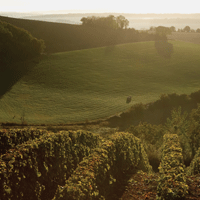The lure of California during a cold Canadian winter is one thing, but the lure of its wine is quite another. In fact, according to the Wine Institute of California, 90 per cent of U.S. wine sales in Canada are from California wines, which sold in excess of five-million cases for the first time in 2012, an increase of 16.2 per cent, compared to the previous year. This impressive growth compares well to the overall wine market, which only grew 3.7 per cent in Canada, according to statistics taken from the Monthly Sales Reports, published by Ottawa’s Canadian Vintners Association (CVA) in conjunction with Ottawa’s Association of Canadian Distillers (ACD).
The numbers add up since California has nearly 2,300 wineries and more than 100 designated wine-growing areas or American Viticultural Areas. What’s more, the climate and soil diversity is so great that nearly any grape can grow in the state. In fact, there are more than 100 varieties grown in California, giving winemakers opportunity to make rare wines and unique blends. And, the good news is The Golden State’s 2012 grape wine harvest broke the previous record for biggest crop ever, totalling 3.885-million tons, according to the Wine Institute of California — great news after a series of short harvests.
Canada benefited from that success, as The Great White North is the largest export market for California wines, with Canucks spending more than $307 million on the product last year, according to the Wine Institute of California. More specifically, statistics compiled from the CVA and ACD show the top three U.S. wine company players in Canada are the usual suspects: E.&J. Gallo with brands such as Apothic, Barefoot, Mirassou and Carlo Rossi; Constellation with brands such as Robert Mondavi, Ravenswood and R.H. Phillips; and Beringer with brands such as Beringer and Chateau St. Jean.
“California wines sell incredibly well. We see strong sales from Chardonnay, Cabernet Sauvignon and Pinot Noir,” confirms Brad Royale, wine director and sommelier at the Calgary-based Canadian Rocky Mountain Resorts. “These have been stable over the past five years; a very solid category.”
Of course, some are more popular than others. “Brands that deliver good performance between $65 and $95 on the wine list sell the most. Producers such as Stuhlmuller, Ridge, Hartford Court, Schug, Skylark, Summers and Merry Edwards all do very well for us,” adds the Rocky Mountain wine director.
It’s clear that, despite the competition from other countries, California wine remains popular. “Californian wines have maintained their bestselling status versus other regions and are seeing increases again after some strong growth from other areas like Italy, South America and South Africa,” explains Dean Campbell, beverage director at SIR Corp., a Burlington, Ont.-based company that owns full-service restaurants such as Canyon Creek, Jack Astor’s and Far Niente. “The top-selling brands are still the most well known — for example, Beringer, Ravenswood, Ironstone, Barefoot Cellars and Sterling Vineyards.”
Anne Martin, head sommelier of the Toronto-based Maple Leaf Sports + Entertainment (MLSE) sees similar patterns. “California wines sell extremely well in our restaurants — in all three of the Air Canada Centre clubs, at E11even and at Real Sports Bar and Grill in Toronto and Ottawa,” she says. “Our fans really love a range of Californian wines, from the more affordable brands all the way up to the exclusive, hard-to-find boutique wineries.”
Lesser-known varietals, wineries and regions in California are gaining interest on the wine scene. “We are having very positive response to [varietals] like Syrah, Pinot Noir and cool-climate Chardonnay from less familiar regions such as the Sonoma Coast and the Central Coast. We are also having a lot of success with the new bold red blends like Apothic Red,” says Campbell.
It helps that today’s consumer is more informed and interested in wine than in years past. “With North American wine consumption rising, people are becoming more experienced with a wider variety of wines,” says Canadian Rocky Mountain Resorts’ Royale. “This gained knowledge overflows into their regular drinking range, making new wines more attractive. California’s grape supply was created out of the cultural influence of immigrants, local ambition and raw imagination. Forward-thinking wineries are looking back to the diversity of what was first presented to the vineyards and are looking to exploit what is creeping around, and then portraying it in a modern version.”
Sir Corp.’s Campbell has a slightly different outlook. “The lesser-known regions give consumers an opportunity to safely explore or try something new since they are confident in the quality that California wines deliver. Many of these regions are also producing a lighter style of wine, which is often better with food pairings. The other consumers driving growth are those who want a bold, full-flavoured wine without the tannins and bitterness — red blends like Apothic.”
There’s no doubt the scene is evolving. “It seems as if many wineries are expanding their portfolios to include less pricey wines to have a wine that is reasonably priced and ready to drink at a younger age, says MLSE’s Martin. “There seems to a trend towards more fun labelling and an irreverent style. There are more unusual grapes and blends being experimented, too.” For example, Healdsburg, Calif.’s Cannonball Wine Company offers well-priced, quality wines with fun packaging.
And, while California wine is good now, Royale can only guess at the state’s future stars. “It is somewhat hard to hold that crystal ball with any real clarity, as markets are so intertwined with vintage yields, grape prices, currency and market swings. There will always be new superstars who will gleam in the glow of headlines, but I suspect we will hear more, and, on a more accessible level, from Arnot-Roberts, Massican and Diatom in the future,” he says.
Campbell contends that we’ll continue to see more diversity and more good California wine for less than $40. “There’s so much competition in the wine world that it makes for great buying opportunities as a consumer,” adds the SIR Corp. beverage director.
All good news for Canadians who have embraced California wines with gusto.




















